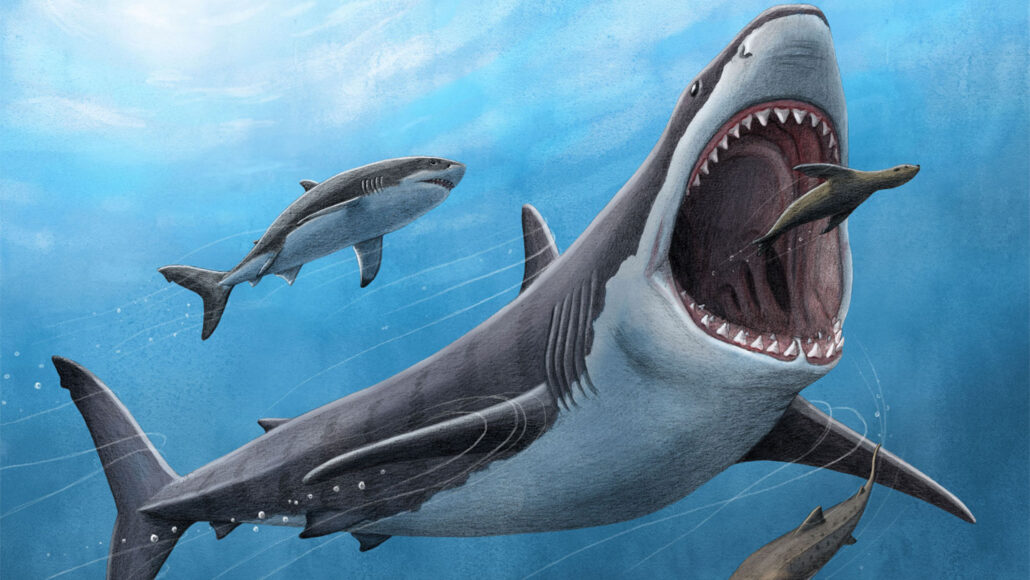Megalodons may have become megahunters by running hot
Warm body temperatures may have helped these ancient sharks swim fast and snag prey

Otodus megalodon (center in this illustration, preying on a seal) was warmer-blooded than the great white shark (top left). That warm-bloodedness may have helped it grow so huge. But as food sources dwindled, that same trait ultimately may have spelled the megalodon’s doom.
Alex Boersma/PNAS
Massive Otodus megalodon sharks — the ocean’s largest meat-eaters ever — ran hot. It now appears that their rise (and fall) may have been tied to their warm-bloodedness.
Chemical measurements on fossil O. megalodon teeth suggest the sharks had higher body temperatures than surrounding waters. Analyses of carbon and oxygen in the teeth revealed that the giant shark’s body temperature was about 7 degrees Celsius (13 degrees Fahrenheit) warmer than seawater temperatures at the time.
That warm-bloodedness may have been a double-edged sword. The trait may have helped megalodons become swift, fearsome apex predators. Those are hunters at the top of the food chain. O. megalodon grew up to 20 meters (66 feet) long. That makes it one of Earth’s biggest carnivores ever. But the shark’s voracious appetite also may have spelled the species’ doom.
A creature’s metabolism is the set of chemical reactions needed to sustain life. Gigantic bodies require a lot of food to power their metabolisms, notes Robert Eagle. A marine biogeochemist, he studies the chemistry of ocean ecosystems. Massive sharks may have been particularly vulnerable to extinction when food became scarce, he says. Eagle was part of a team that studied fossils of O. megalodon — and its living and extinct kin — to learn about the animals’ metabolisms.
Game over for megalodons
Mammals can boost their metabolisms and maintain their body heat, even in colder environments. This trait is called endothermy or warm-bloodedness. Some families of fish, both living and extinct, can do something similar. They can keep some body parts warmer than the surrounding water. This is known as regional warm-bloodedness. Many modern sharks belonging to the group that includes great white sharks have this ability.
Jacking up the temperatures of some body parts is one way some sharks evolved to be giant, says Jack Cooper. A paleobiologist, he studies ancient life at Swansea University in Wales. He did not take part in the new study. Filter feeding offers another path to getting large, Cooper points out. Gentler giants, such as whale sharks, use this strategy when they gulp lots of water and eat the tiny creatures within.
Scientists have long thought megalodon was regionally warm-blooded, Eagle says. Estimates of this beast’s body shape, swimming speeds and energy needs point to some warm-bloodedness. The shark also was known to hunt in both colder and warmer waters. That suggests it had some control over its body temperature.
The question, Eagle says, isn’t really whether O. megalodon was warm-blooded. It’s how warm-blooded. His team wondered how the megashark’s internal temps compared to one of its major competitors: the great white shark.
O. megalodon evolved around 23 million years ago. It went extinct sometime between 3.5 million and 2.6 million years ago. Great white sharks emerged late in megalodon’s reign, roughly 3.5 million years ago. They competed for food with their massive cousins.
Some scientists suspect this competition helped drive O. megalodon to extinction, especially when food became scarcer. The climate changed during the Pliocene Epoch, which spanned 5.3 million to 2.6 million years ago. That led to a sharp drop in the numbers of marine mammals. They were a primary food source for both sharks.
But the great whites stuck around when O. megalodon died out, Eagle says. Being the much smaller of the two, they likely needed less food to maintain their metabolism.
Ancient temperature check
To study the ancient sharks’ body temperatures, the team turned to the only fossils left by these sharks: their teeth.
Fossilized teeth can say a lot about the bodies they came from. A tooth’s enamel contains isotopes, heavier and lighter forms of a chemical element. Eagle’s team examined chemically bonded forms of heavier-than-usual carbon and oxygen. The technique acted as a kind of ancient thermometer. The abundance of bonds between these isotopes is only affected by body temperature, Eagle says.
The team used this technique on teeth from great whites and megalodons. They also used it on other animals who lived at the same time. Mollusks are entirely cold-blooded; they can’t control their body temperature. Analyzing ancient mollusks revealed the ocean’s water temperature.
Great whites and megalodons were at least somewhat warm-blooded, the team found. A megalodon’s body was warmer than the water around it. It also was warmer than the bodies of great white sharks. Neither shark, however, was as warm-blooded as marine mammals, such as whales.
The researchers shared their findings June 26 in Proceedings of the National Academy of Sciences.
It’s fantastic that we have more evidence for regional warm-bloodedness in megalodon, Cooper says. O. megalodon’s higher body temperature would have allowed it to swim further and faster, he says. That increased its chances of finding prey. But when the sharks’ prey dwindled some 3 million years ago, he says, megalodon “may well have starved into extinction.”
Eagle’s team is now exploring the chicken-or-egg question of which came first for megalodons: warm-bloodedness or apex-predator status. You need to be big to be a mega-predator. But it’s not clear whether carnivores need to be warm-blooded to become apex predators. “We’re hoping to fit it all together into an evolutionary story as to what drives what.”







